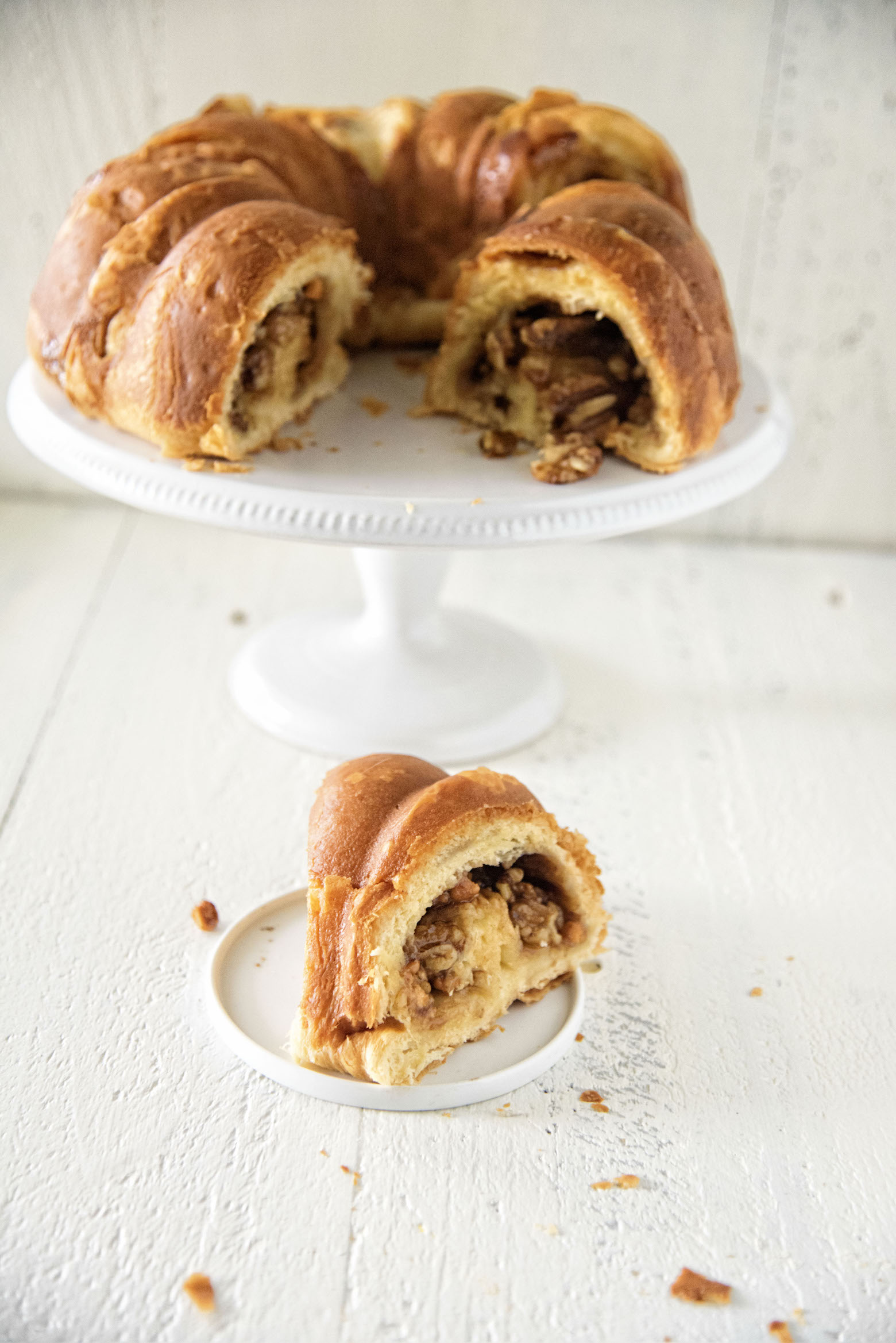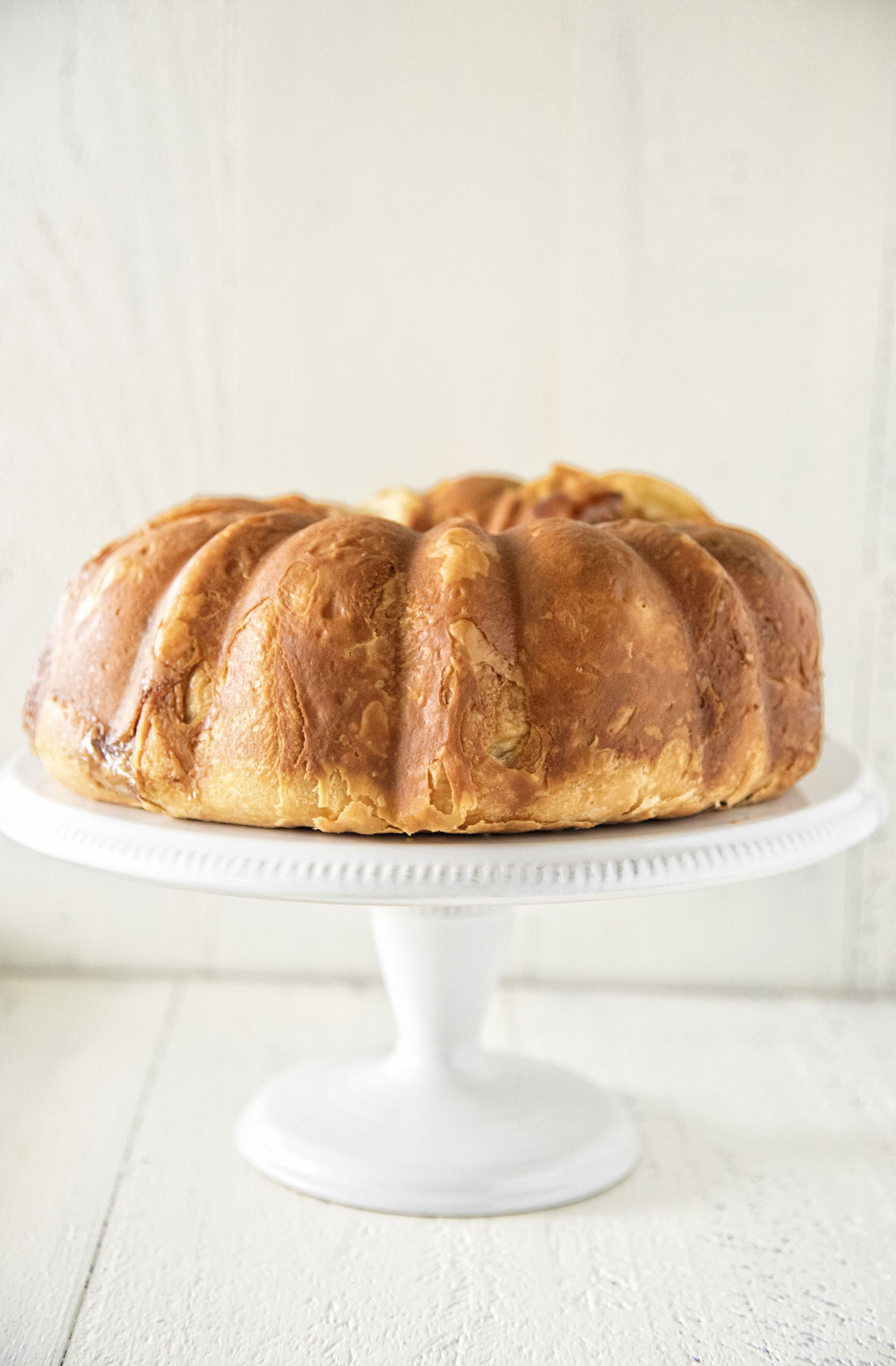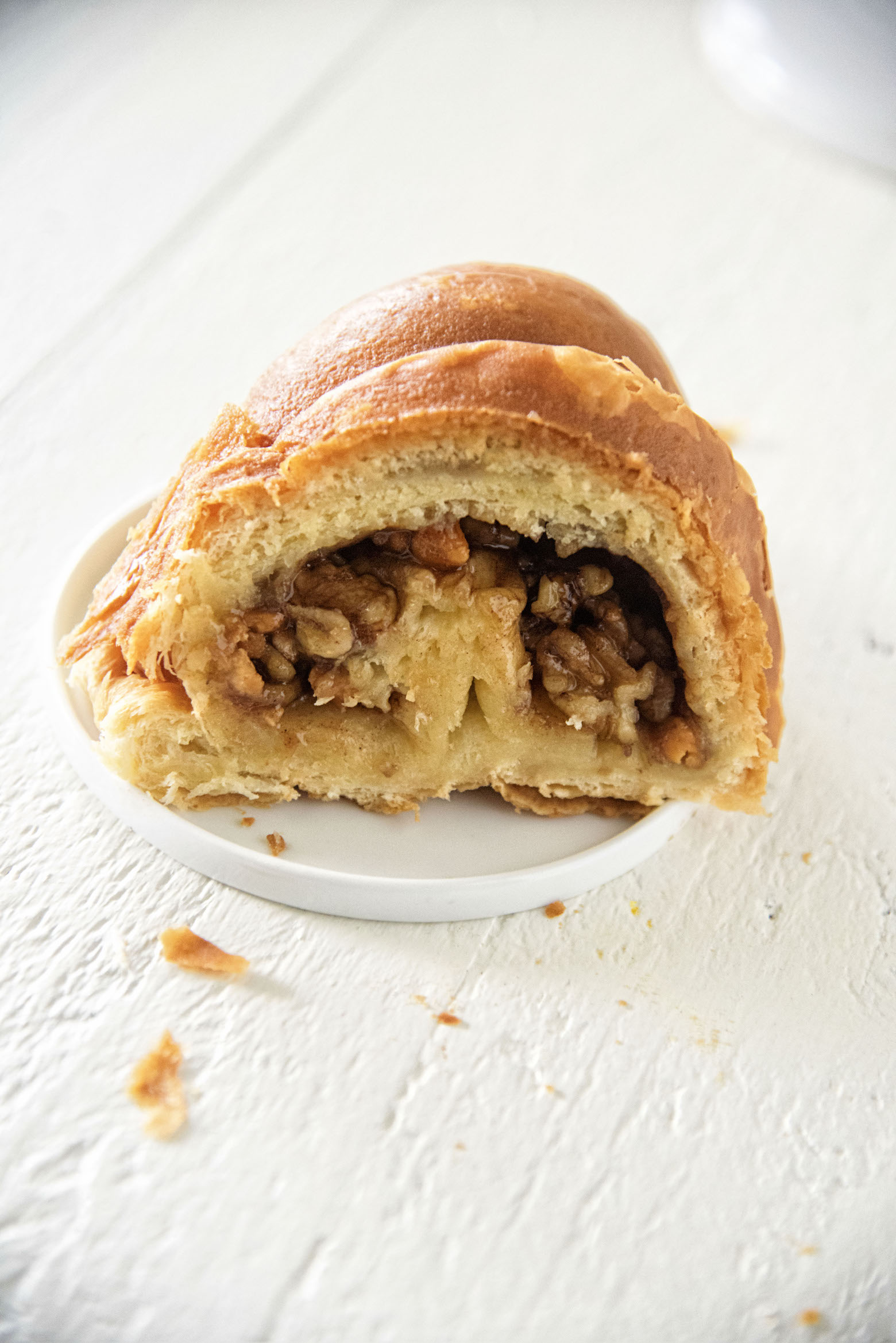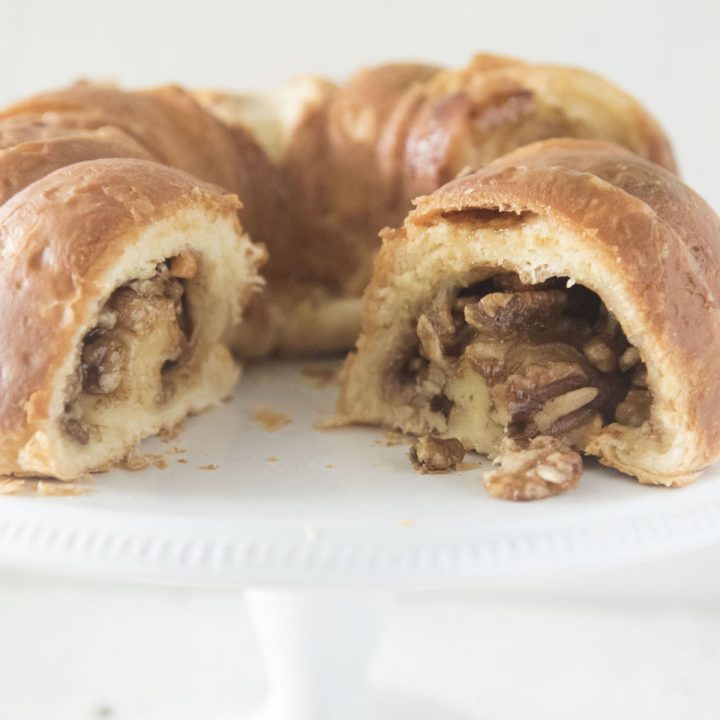Forget about trying to pronounce it and just eat this Butterscotch Walnut Kugelhopf filled with cinnamon, brown sugar, walnuts, and butterscotch chips.

So full disclosure…I made this Butterscotch Walnut Kugelhopf back in September 2018.
I was making a ton of things back then.
Therefore having a surplus of recipes to choose from to post.
Ironically, this was my favorite of the things I made to eat in all of 2018.
But to write out the recipe would take forever and so I played the lazy card and kept putting it off.
Until it was the last recipe in draft.
Which is today. 🙂
So I forced myself to sit down and write it all out.
Even though the steps are long, this is definitely worth it.

My husband keeps asking me to make it.
The lamination part can be tricky, as it’s similar to making croissants.
But there is this video someone took of them making the kugelhopf.
It’s a much larger scale but hopefully it will give you the idea.
The cake is baked in a Bundt pan which intrigued me.
But I like how using the pan makes it a little more uniformed in shape.
I skipped dusting it with powder just because I was out of it at the time. 🙂
Also, I have no idea how to pronounce it.
Luckily you don’t have to pronounce it to get to eat it. 🙂

Want More Bread Recipes?
Orange Blossom Chocolate Challah Bread
Oatmeal Chocolate Chip Cookie Babka
Brown Sugar Spiral Banana Bread

Butterscotch Walnut Kugelhopf
Ingredients
- For the Sweet Brioche Dough:
- ¼ cup lukewarm water (about 80F)
- ½ cup sugar, divided 1 ½ tsp. active dry yeast (I used Red Star)
- ¾ cup lukewarm whole milk (about 80F)
- 1 tsp. pure vanilla extract
- 2 large eggs
- 3 ½ cups unbleached all-purpose flour
- 1 tsp. salt
- ½ cup (1 stick) unsalted butter, at room temperature
- For the Kugelhopf:
- 1 recipe Sweet Brioche Dough
- 1/2 cup unsalted butter, cut into quarter pieces, at room temperature
- 1 TBSP ground cinnamon
- 1 cup dark brown sugar, packed
- 2 cup walnuts
- 1 cup butterscotch chips
- 1/2 cup unsalted butter, melted
Instructions
- For the Brioche Dough:
- Lightly oil a medium bowl with vegetable oil. Set aside.
- In the bowl of a stand mixer fitted with the dough hook, combine the water with 2 teaspoons sugar (taken from the ½ cup sugar).
- Sprinkle the yeast over the surface of the water. Mix until the yeast is dissolved, then let the mixture sit for 5 minutes to activate the yeast.
- Add the milk, vanilla, eggs, flour, and salt.
- Mix on low speed for 3 minutes to bring the dough together, stopping to scrape down the bowl as needed.
- Increase to medium speed; pinch off grape-size pieces of butter and drop them one at a time into the dough as it mixes (this should take no more than 2 minutes). Continue mixing for 2 to 3 more minutes.
- Now gradually add the remaining sugar (½ cup minus the 2 teaspoons) and continue mixing for a final 4 minutes.
- With floured fingers, pinch a big piece of dough and pull it away from the mass.
- It should stretch about 3 inches without tearing – it will feel a bit like a rubber band. If it tears, mix for another 1 to 3 minutes.
- Using a rubber spatula, transfer the dough from the bowl onto a floured work surface.
- For the dough into a ball and place it in the prepared bowl.
- Cover with plastic wrap and let the dough rise at room temperature until it has doubled in size, 2 ½ to 3 hours. (If you are making the dough ahead – either for convenience or to develop more complex flavors – simply deflate it after this initial rise, then re-cover it with plastic wrap and refrigerate overnight.
- The next day, pull it out 2 hours before you want to use it, and allow it to come to room temperature.
- The dough should be doubled in size and feel slightly warm to the touch.
- This dough is best used by the second day.
- For the Kugelhopf:
- Flour a rimmed baking sheet and grease a 10 inch bunt pan with vegetable oil, making sure to oil all decreases. Set aside.
- Using a rubber spatula, pulled the brioche dough out onto a floured work surface.
- Using a rolling pen and a dusting of flour, shape the dough into an 8 x 16" rectangle, with the long side facing you.
- Using your fingertips, press that though, marking it crosswise so it visually divided into three equal sections.
- Laminate the dough by layering it with additional butter: with your fingertips smear the butter pieces on two adjacent sections of the dough
- If the butter is cold, it won't spread and we'll tear the dough, so make sure it is sufficiently soft.
- Using an offset spatula, spread the butter in an even layer across the two sections.
- Using your indentations as a guide, fold the unbuttered third onto the center third.
- Then full the far third (with butter) on top.
- Even out the edges on all sides and slightly flatten to make the rectangle easier to roll out.
- Rotate the dough a quarter turn and roll it out again 288 by sixteen inch rectangle.
- Make the same single fold (this time you will not use butter; just folded go into thirds as before).
- Transfer the go to the prepared baking sheet and cover with plastic wrap.
- Refrigerate for one hour to relax the gluten and cool (but not completely chill the mass of the dough and butter).
- Meanwhile prepare the filling.
- Combine the cinnamon and brown sugar in a medium bowl.
- Add the walnuts, butterscotch chips, melted butter.
- Using a rubber spatula, mix well and set aside.
- Transfer that over the baking sheet to a floured work surface.
- With a rolling pin, roll it out into an 8 x 20-inch it should be about 1/2 inch thick.
- With the long side facing you, spread the feeling over the dough, leaving a 1 inch border along the edge nearest to you.
- Starting with the ex farthest away, roll the dough toward your body.
- When you reach the border, stopped rolling.
- Use your finger tips, Flatten the dough along the very edge of the border so that it is quite send. Then finish rolling the log.
- The thin edge acts as a sealer.
- Let the log rest, seam side down, on your work surface for a few minutes to secure the seal.
- Flip-flop over so the seam side is up and bring the ends together; join them by talking one side into the other.
- Drop the circle of dough into the prepared pan.
- Press the dough down so it fills the pan and the air pockets are deflated.
- Check for seen edge: if you notice of the seam is coming apart at any time during the rise just pinched a reseal.
- Let the kugelhopf rise at room temperature until the loaf just crests the pan, about two hours.
- About 20 minutes before baking, position a rack in the center of the oven in three hundred and thirty preheated 330°F.
- Bakes the loaf for 45 to 50 minutes, or until the top is a golden brown.
- Cool it in the pan for 40 minutes (if turn out right away, it will collapse), then turn it out onto a wire rack and cool completely.
- Allow the kugelhopf to rest for one hour, then dust with confectioners' sugar, sliced with a serrated knife, and serve.
Adapted from More from Macrina Bakery
J says
Wow Peabody…52 steps! No wonder you put off writing this one out coz I would too! 😂
I’ve never seen such a long recipe but it looks and sounds soooooo good! It must of been a day’s work to make too!
Peabody says
It actually did not take that long. Seriously…it took me longer to write it out than to make it. 🙂